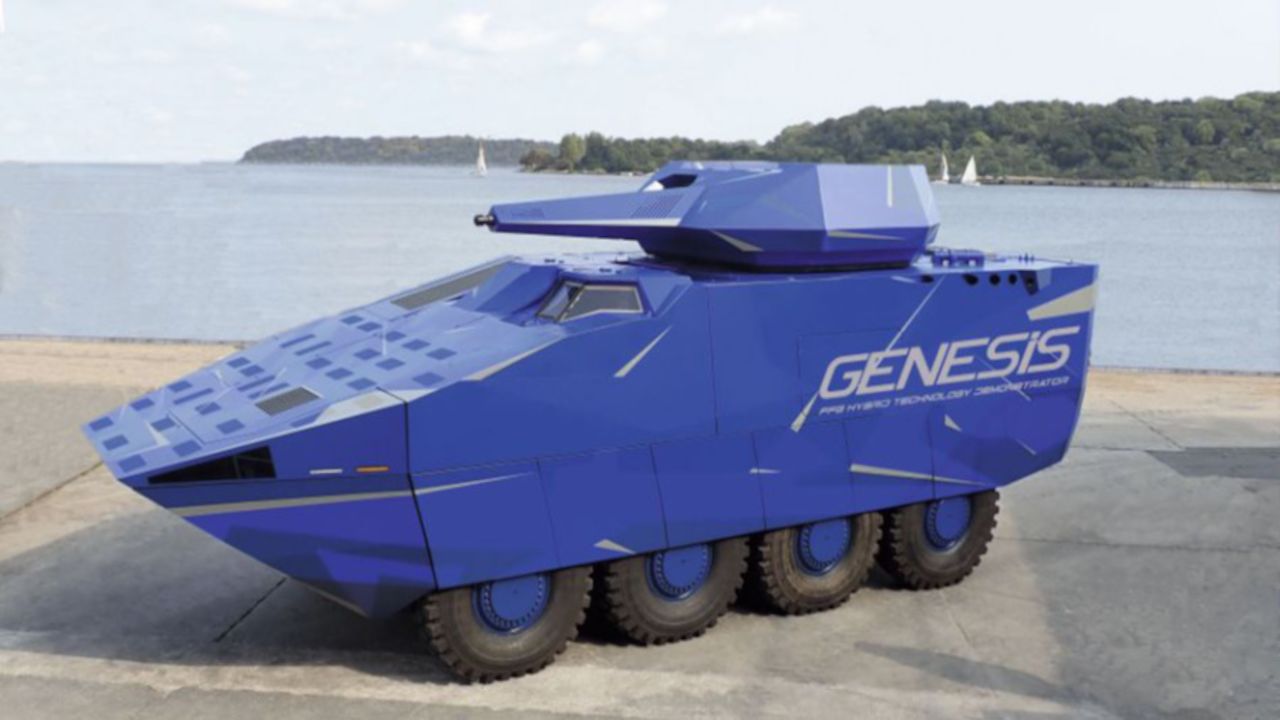Flensburger Fahrzeugbau Gesellschaft mbH (FFG) has displayed the GENESIS full hybrid technology demonstrator for the first time. This is the first 8×8 Armoured Fighting Vehicle with a full hybrid drive, individual wheel speed control and recuperation. The exhibited vehicle is fully functional according to company statements with only the 30 mm Kongsberg turret installed but not yet connected due to time constraints.
The presentation took place in connection with an accompanying exhibition at the Förderkreis Heer Symposium “Current Challenges and Perspectives of Medium-Sized Defense Technology Companies as a Driver for Capability Maintenance and Technology Innovation” (running from 22nd to 23rd September) at the FFG premises in Flensburg. The world premiere, originally planned for Eurosatory 2020, had to be postponed due to the COVID 19 related cancellation.
With the presentation of the completely self-financed study, FFG intended to showcase the know-how currently available in the company in the fields of propulsion technology, software development and electronics in order to position itself as a technological supplier for the successor of the future reconnaissance vehicle (FENNEK successor) or the Main Ground Combat System (MGCS). The development of the demonstrator was started by FFG two years ago.
The vehicle
The GENESIS is based on a modular concept similar to the BOXER, consisting of separate driving and mission modules. The propulsion of the former is diesel-electric and has a total installed power of 1,368 kW, with the diesel generator only used to generate electricity for the electrical storage unit, which is also located in the front part of the vehicle. The electrical energy stored there is used to drive the eight electric motors located in the axles, which in turn transmit up to 15,622 Nm torque to the individual wheels via individual drive shafts. The heart of the drive is the vehicle’s all-electric drive by wire control system. There is no physical connection between the driver’s controls and the wheels with the necessary know-how also developed by FFG’s own software department. The steering of the vehicle is done in a similar way to a tracked vehicle by regulating the torque of the individual wheels. According to FFG, the technology is fully scalable and also suitable for 4×4 or 6×6 vehicles. Should individual motors or wheels fail, they can be set to idle so that the vehicle can continue its mission.
Since the powertrain is completely without transmission and steering elements, there are no costs for the purchase and maintenance of these components, which are necessary for conventional drives. The diesel-electric drive offers further advantages as it enables noiseless driving or operation of the observation and communication devices with the engine switched off (Silent Watch). In this case, the ventilation system, which is only necessary at certain temperatures, and the driving noise of the tires would be telltale sources of noise, but these are significantly lower than those of conventional drives. In addition, the electric motor has a high tracking capability because, unlike the internal combustion engine, it has full torque even when stationary. At the same time, electric vehicles can serve as “electricity filling stations”.
In order to protect the vehicle’s crew from harmful electrical hazards in the event of combat damage, several safety features have been implemented to disconnect the electrical connections between the vehicle’s hull and electrical storage unit.
The modular design of the vehicle allows a relatively simple implementation of different mission configurations via autonomous mission modules. The exhibited module showed a wheeled Infantry
Fighting Vehicle (IFV) version with a Kongsberg unmanned 30 mm turret including combat compartment for up to ten infantrymen.
FFG now intends to extensively test the GENESIS to gain further insights for the design of potential future combat vehicles.
| Technical Specifications Genesis | |
| Crew | 2 + X |
| length | 8,25 m |
| width | 2,25 m |
| height | 2,40 m |
| Weight (incl. module) | 40 t |
| engine power | 1.368 kW |
| Peak torque | 15.622 Nm / wheel |
| Speed | > 100 km/h |
| climbing ability | 60% / 30% |
| Range | 150 km at 40 km/h (electric) |
| Travel range | 600 km at 60 km/h (diesel-electric) |

